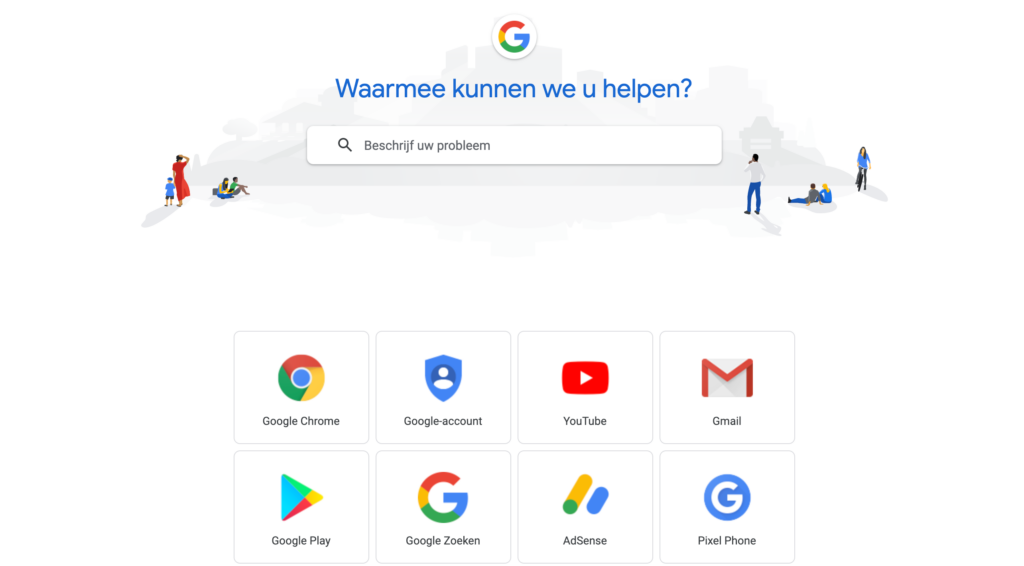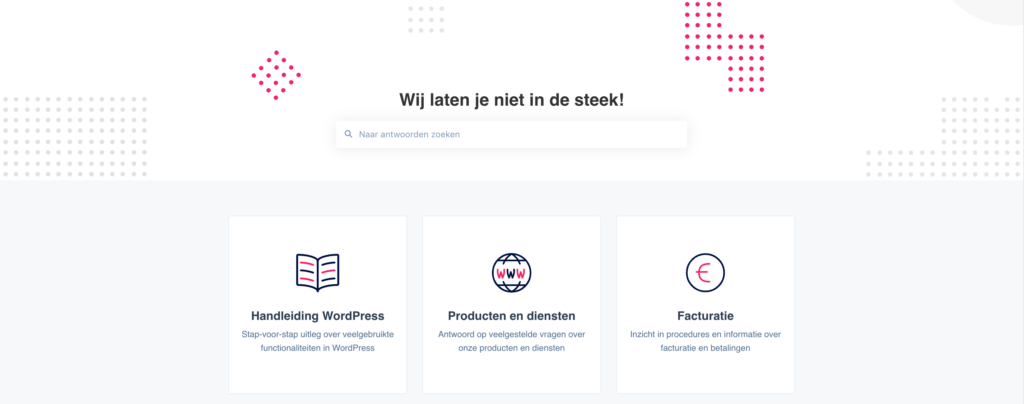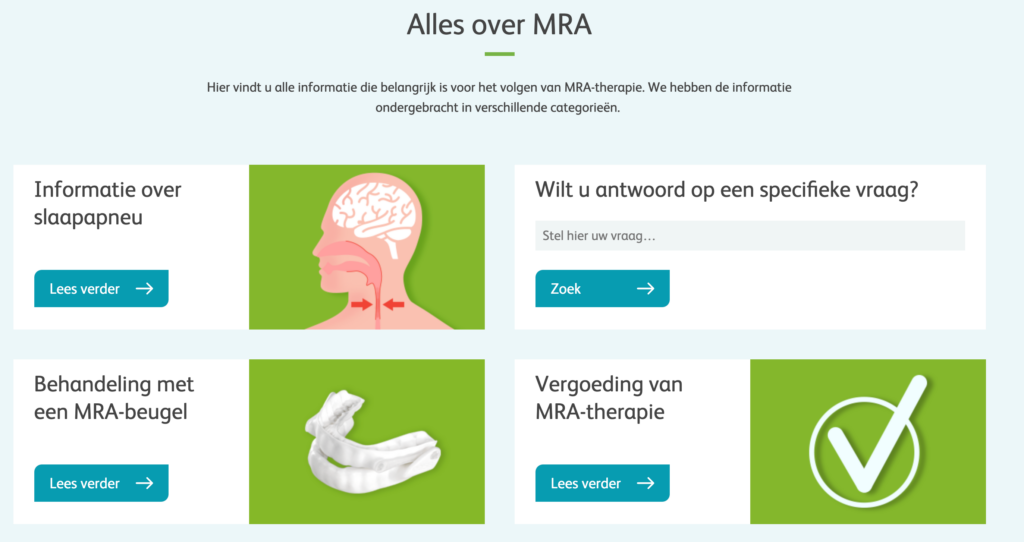

Developing and executing the perfect marketing strategy for your company is difficult. We are happy to give you a helping hand.

A close-knit group of people who breathe the Tilburg atmosphere and have the ambition to always go a step further.


Many companies use their website as a business card, for recruitment or as a contact option. In addition, most companies offer customer service through e-mail, contact forms or telephone. These are all time-consuming tasks that are often responded to adhoc. Being able to quickly help customers and clients with questions and problems can be difficult as a result. This is a thing of the past with support websites.
We live in a time when many people conduct their business online. Being on hold on the phone causes irritation and wasted time for many people. As a result, they start looking for solutions online. Visitors to your website want to be able to find answers to their questions quickly. How can you best help these people without taking a huge amount of your time to respond? A support website helps customers who have a question about, or problem with, your service or product. This is also called a self-service portal.
Especially in times when the corona crisis makes physical meetings impossible, providing online support and information is crucial. This can set your company apart from the competition. Recent times have shown that having a support website or self-service portal fits perfectly with the current zeitgeist. Indeed, it enables remote service.
A self-service portal helps customers find and consume information, it offers both customer and service provider unity of communication, grows with them, increases (cost) efficiency and creates space.
A support Web site is a section where customers or clients can manage their own affairs. Consider a customer portal, a Frequently Asked Questions (FAQ), a knowledge base or a chatbot. The point is that visitors to the website can get answers to their questions on their own, without having to contact one of your employees directly. Thus, common questions can be tackled instantly online. This does not mean that visitors can no longer contact you directly at all. You only encourage the visitor to look for the answer himself first. This benefits both the visitor and your company: you both save time (and possibly money).
Some examples of online support explained:
Put frequently asked questions, including answers, under one page. For example, on the contact page, refer to the FAQ first before visitors contact you. The advantage of a good and up-to-date FAQ, is that it can greatly reduce the pressure on a customer service department. Users become self-reliant when they can search for an answer to their question themselves.
A knowledge base is a larger version of an FAQ; it contains much more content. For complex questions or large topics, it’s better to set up a knowledge base. For each question, create a page. In this way, the customer receives a comprehensive explanation to their question, such as by means of a step-by-step plan. Where possible, categorize questions and answers by category. This way you maintain structure in large amounts of information and articles. In addition, adding relevant content in a structured manner has a positive effect on your SEO values; the findability of your website in Google is thereby increased.
Many companies have a customer portal. This is a separate section of the website where customers can log in to see and edit their personal information. In addition, customers can, for example, view the history of purchases or invoices and change or repeat orders. These types of portals exist in many different forms, for different services. The great advantage of such a portal is that it is an environment where you can always have contact with the customer. So this is an additional service for the customer portal user, and makes the service transparent.

There are two different types of chat boxes: a live chat and a chatbot. You can use the chatbot before a user actually chats live with one of your colleagues. A chatbot is an automated, virtual assistant. So this is a robot chatting with a user. How exactly does that work? The customer opens a new chat on the website and asks the robot a question, to which it returns an automated response. With scripted bots, the user can choose from a limited number of choice questions: the conversation is more guided in such a case.
For example, a chatbot can figure out what the question is about or what the reservation or ticket number is. It can also answer frequently asked questions directly. This ensures that employees chatting live with the user can resolve the query more quickly because they have the basic info already passed on by the customer. It also lowers the pressure on customer service by allowing the chatbot to potentially solve some standard questions itself.
A chatbot comes in all shapes and sizes: there are basic robots that only answer frequently asked questions, but there are also very elaborate variants. For example, large companies and organizations create features for their chatbots that add to the database any questions that have not been answered before. Thus, chatbots are getting smarter and smarter.
When customers do not have the ability to contact you through the above options, they may end up at a contact form. This is where customers fill in their question and details. Then, as a company, you can respond to this form via email or a call-back request, at your convenience. The downside is that this is a time-consuming job. In addition, customers are not helped immediately. Offering a contact form as the only (online) option, therefore, is not recommended.
Want to know the extent to which a support website will benefit you and your customers? Then download our support websites checklist to find out what is needed for such a self-service portal.
A question seeks an answer. Self-service eliminates an intermediate step and puts the customer directly in touch with the most likely answer. This has benefits for both stakeholders:
From a business perspective
From a customer perspective

Good support websites consist of an option for customers to search for answers themselves (self-service portal) as well as an option to contact them. But why is that important?
Internet use on both computer and mobile is increasing every year: people are doing more things online. The corona crisis has accelerated digitalization. Physical appointments were not possible, so people started contacting them by phone and online. This can increase pressure on customer service, such as at Vivisol, which facilitates medical home care. Because they had a support Web site built, they quickly had all their business back in order and gained a competitive advantage. Not to be left behind, having an online strategy and being able to appeal to your target audience online is a must in today’s online marketing landscape.
When you can offer online support, this is a more efficient way of communicating for both your company and the customer. Go figure: the user no longer has to be on hold by phone, wait for a written response, consider opening hours or send an e-mail. Instead, the user actively searches for the solution to the problem himself. Should it still fail, the customer knows where to contact directly.
On the other hand, if you have a good support site, you as a company need to employ fewer customer service representatives. This saves both time and money. Also, the questions you get are solved faster. In addition, you offer users clarity on where to go with what questions.
In today’s zeitgeist, people are increasingly accustomed to being flexible with their time. Shopping in the evening, calling customer service on weekends and tracking your ordered packages anytime, anywhere via your smartphone. As a company, you want to provide flexible service, but logically, you don’t want to and can’t be available at all times. By setting up a support website, however, you can give the idea that you are always there for your customer. A user can log into the customer portal 24/7, always view the FAQ or be helped by a chatbot. This way, the customer never feels let down.
A big advantage of support websites is that they can store a lot of information. A knowledge base provides comprehensive answers to all kinds of questions and can be expanded all the time. So you can keep tinkering with your FAQ and knowledge base, making the information on your website ever better and more complete. So this also has positive implications for Google ranking.

Yes. But what costs more: describing a question and updating it regularly or repeating that question daily?
The goal of self-service is to provide quick and easy answers. Those seeking these answers are likely to be annoyed by the lack of missing or incorrect information in the database. This means that the self-service components must be updated regularly.
This solution is no substitute for personal contact with your constituency. It serves as a modern and findable alternative to time-consuming, error-prone and costly customer service.
For many consumers, customer support is their most important interaction with companies after the sale. For this reason, customer service has become a loyalty battleground, with each company trying to do it smarter than others. Giving customers the wow factor with self-service is not easy. Self-service has as its strategy effortlessness; that may not lead to the same positive word-of-mouth as a wow moment.
Poorly implemented customer support can be tremendously irritating. Poor design or implementation can make a self-service portal difficult to navigate or even provide the wrong answers. For that reason, we create UX design, develop based on best-practices and advise during and after going live of your self-service portal.
Perhaps the most important reason for having support websites is to increase customer satisfaction: after all, that’s what you do it all for. Your service level goes up and users can be helped faster. Having a customer portal also promotes transparency: all personal information is easily found together here. A support website focuses on providing information and the user. Such a customer-centric approach inspires confidence.
Not only will your current clients notice that more information can be found: potential clients or customers can also find you better. By building on your content and site structure, you not only satisfy your current customers but also bring in more leads. More benefits of having support websites will be discussed in one of our blogs.
The importance of online will only increase in the future. Therefore, it is good to think about new ways to address, inform and help your target audience with questions and problems. Still not convinced or want to know more? Then download our support websites checklist. With this list, you can see in a few minutes what is important for developing a support website. Want to read a more comprehensive document? Then the support websites white paper is for you. A good start is half the battle!